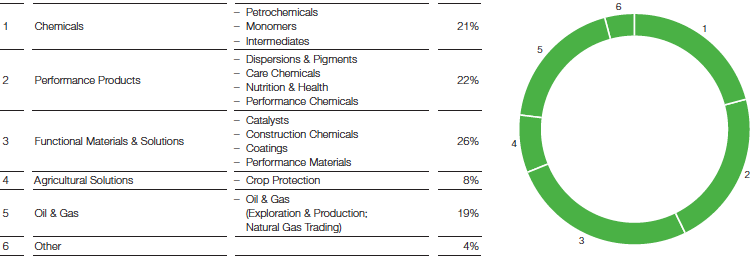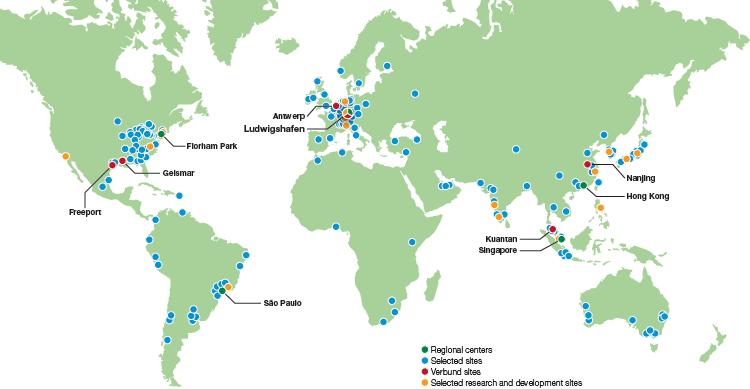The BASF Group
At BASF, we create chemistry for a sustainable future. As the world’s leading chemical company, we combine economic success with environmental protection and social responsibility. The approximately 112,000 employees in the BASF Group work on contributing to the success of our customers in nearly all sectors and almost every country in the world. Our portfolio is arranged into five segments: Chemicals, Performance Products, Functional Materials & Solutions, Agricultural Solutions and Oil & Gas.
Global leader
BASF is the world’s leading chemical company
In 80+ countries
Employees contribute to our success
Broad portfolio
5 segments
13 divisions
84 strategic business units
Organization of the BASF Group
- Thirteen divisions grouped into five segments
- Regional divisions, corporate units and competence centers support our business
Since the beginning of 2015, thirteen divisions divided into five segments bear operational responsibility and manage our 61 global and regional business units. The divisions develop strategies for our 84 strategic business units and are organized according to sectors or products.
BASF structure
Percentage of total sales in 2015
At the end of September, we rearranged our activities in the Oil & Gas segment, which are bundled into the Wintershall Group. As part of the asset swap with our partner Gazprom, we handed over our shares in the previously jointly run natural gas trading and storage business and in return are expanding our oil and gas production in western Siberia. We continue to operate the natural gas transport business together with Gazprom, but do not report on it separately.
The regional divisions contribute to the local development of our business and help exploit market potential. They are also responsible for optimizing infrastructure for our business. For financial reporting purposes, our divisions are organized into the following four regions: Europe; North America; Asia Pacific; and South America, Africa, Middle East.
Three central divisions, six corporate units and ten competence centers provide services for the BASF Group in areas such as finance, investor relations, communications, human resources, research, engineering, and site management, as well as environment, health and safety.
BASF sites
Markets and sites
- BASF with companies in more than 80 countries
- Six Verbund sites and 338 additional production sites worldwide
BASF has companies in more than 80 countries and supplies products to a large number of business partners in nearly every part of the world. In 2015, we generated 42% of our sales (excluding Oil & Gas) with customers in Europe. In addition, 27% of sales were achieved in North America; 22% in Asia Pacific; and 9% in South America, Africa, Middle East. Based on the entire BASF Group, 52% of our sales were to customers in Europe, 22% in North America, 18% in Asia Pacific and 8% in South America, Africa, Middle East.
We operate six Verbund sites and 338 additional production sites worldwide. Our Verbund site in Ludwigshafen is the world’s largest integrated chemical complex. This was where the Verbund principle was originally developed and steadily honed before being put into practice at additional sites.
Verbund
- Intelligent plant networking in the Production Verbund
- Technology and Know-How Verbund
The Verbund system is one of BASF’s great strengths. Here, we add value as one company by making efficient use of our resources. The Production Verbund, for example, intelligently links production units and energy demand so that waste heat can be used as energy in other plants. Furthermore, by-products of one plant can serve as feedstock elsewhere. In this system, chemical processes run with lower energy consumption and higher product yield. This not only saves us raw materials and energy, it also avoids emissions, lowers logistics costs and makes use of synergies.
We also make use of the Verbund principle for more than production, applying it for technologies, knowledge, employees, customers, and partners, as well. Expert knowledge is pooled into our global research platforms. ![]()
Competitive environment
BASF holds one of the top three market positions in around 70% of the business areas in which it is active. Our most important global competitors include AkzoNobel, Clariant, Covestro, Dow Chemical, DSM, DuPont, Evonik, Formosa Plastics, Reliance, Sabic, Sinopec, Solvay and many hundreds of local and regional competitors. We expect competitors from emerging markets to become increasingly significant in the years ahead.
Corporate legal structure
As the publicly traded parent company, BASF SE takes a central position: Directly or indirectly, it holds the shares in the companies belonging to the BASF Group, and is also the largest operating company. The majority of Group companies cover a broad spectrum of our business. In some, we concentrate on specific business areas: The Wintershall Group, for example, focuses on oil and gas activities. In the BASF Group Consolidated Financial Statements, 251 companies including BASF SE are fully consolidated. We consolidate seven joint operations on a proportional basis, and account for 32 companies using the equity method.
Compensation Report and disclosures in accordance with Section 315(4) of the German Commercial Code
The Compensation Report and the disclosures required by takeover law in accordance with Section 315(4) of the German Commercial Code (HGB) can be found under Corporate Governance. They form part of the Management’s Report audited by the external auditor.

